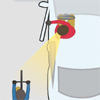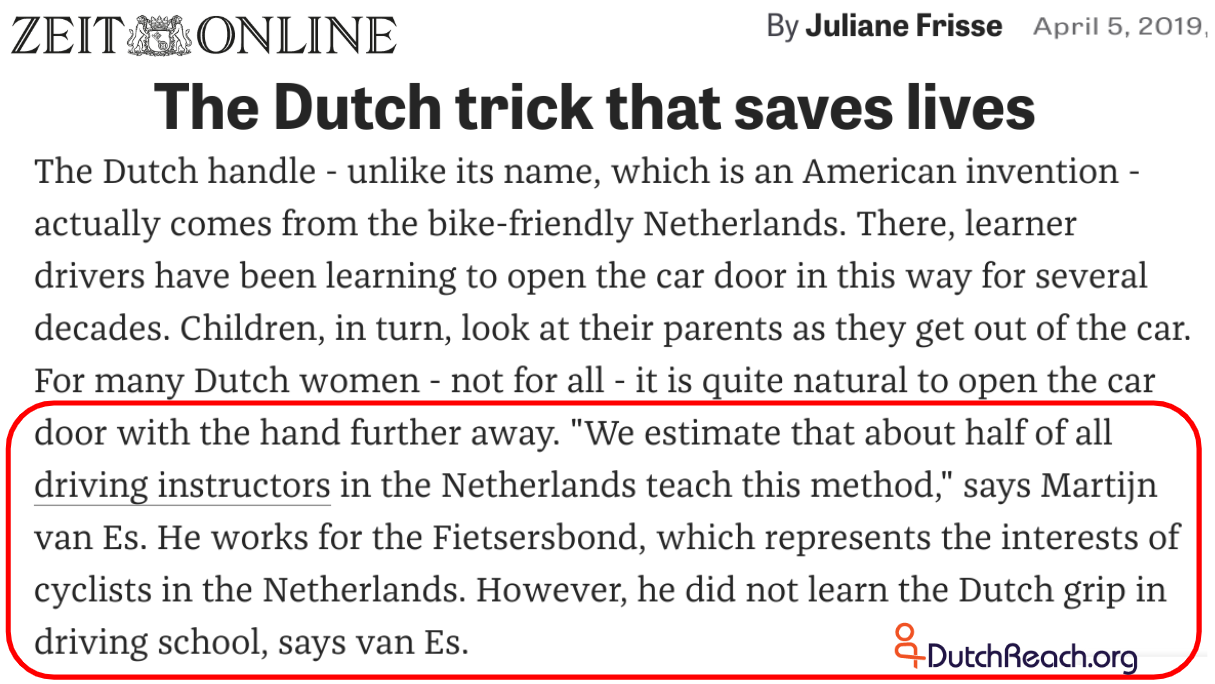Also see: Dutch Law & Culture
Note: Professor Ruth Oldenziel of Eindhoven University is the lead editor for Cycling Cities: The European Experience. Hundred Years Policy and Practice. View video of Prof. Oldenziel on cycling & sustainability.
A Dutch Driving Instructor Teaches the [Dutch] Reach!
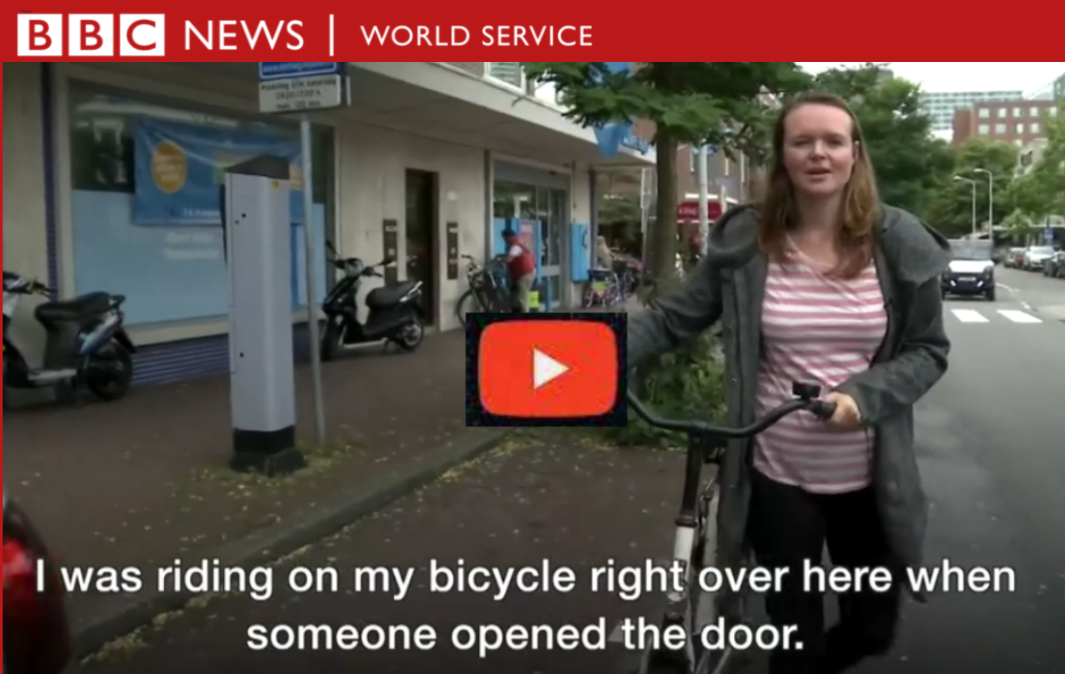
How to do the 'Dutch reach' - And how it could save someone's life. BBC News/Europe & The Royal Society for the Prevention of Accidents, Sept 11, 2017.
Dutch Ambassador: "It's in our DNA."

Netherlands' Ambassador to Canada demonstrates the 'Dutch reach', In North America, it's called the "Dutch reach," but in the Netherlands, they don't even need a name for it — it's that common. "It's in our DNA ...." - Ottawa Morning, CBC, 25 April 2019. Article & gif .
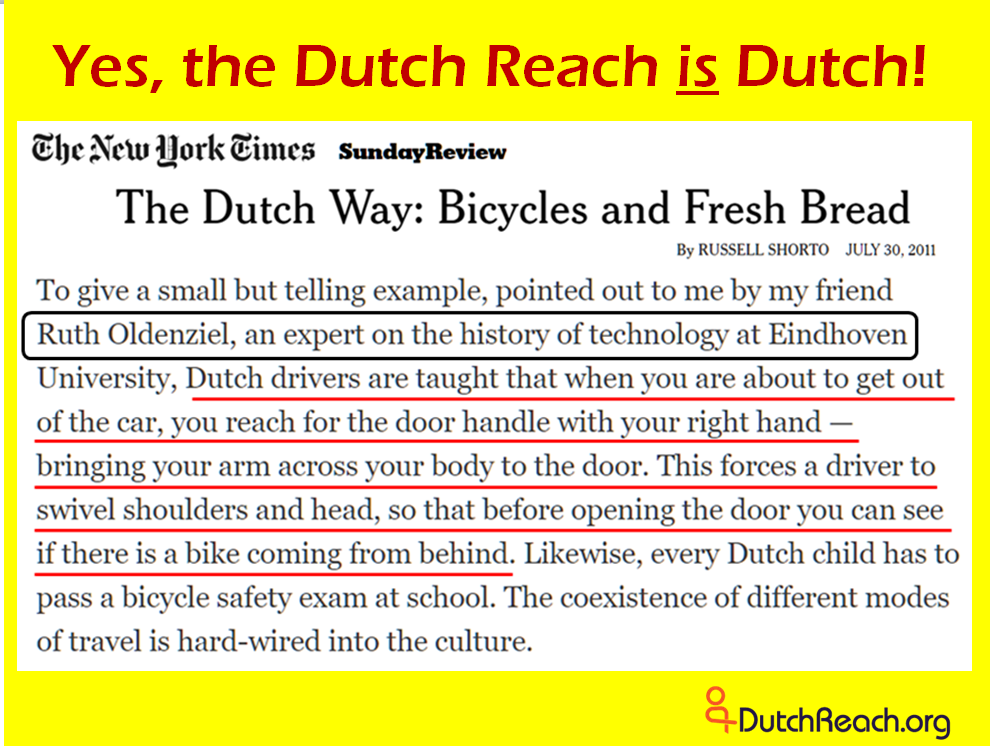
Professor Ruth Oldenziel, Eindhoven Univ., NL confirms that the far hand method has been commonly taught & used in The Netherlands. New York Times, 30 July 2011, by Russell Shorto.
Informal Status of 'Reach' in NL
Dutch grip not mandatory for driving lessons and exams
The Central Bureau for Driving Skills (CBR) is responsible for conducting the traffic exams for motorists. The institution informs NU.nl that the Dutch grip is not mandatory during driving lessons and driving exams.
According to the CBR, the Dutch grip can help to see fellow road users when getting out. "That is why there are driving schools that teach their students this method," says a spokesperson.
“It’s part of regular driver education.” - Prof. Fred Wegman, Smarter Living, NYT
To watch out for the 30 percent of commuters who pedal to work, generations of Dutch drivers have been taught to open car doors with a mindful pivot. “It’s just what Dutch people do,” - Wegman, Mobility Lab
Emeritus Prof. Fred Wegman, Delft Univ. & SWOV
Delft University Emeritus Prof. of Traffic Safety Fred Wegman is a leading authority on Dutch & international road safety practices. In the following articles he confirms Dutch use of the far hand practice based on his personal experience & professional knowledge. The New York Times (5 Oct 2018) and Mobility Lab (11 Dec 2018) each quote Prof. Wegman who describes the far-hand method for safe egress as a long-standing common practice in The Netherlands. Wegman was managing director of SWOV, the Netherlands Road Safety Institute, from 1999 to 2009. He has published extensively in his field as well as contributing to road safety planning in many countries.
NYT's Re-confirms 'Reach' Provenance
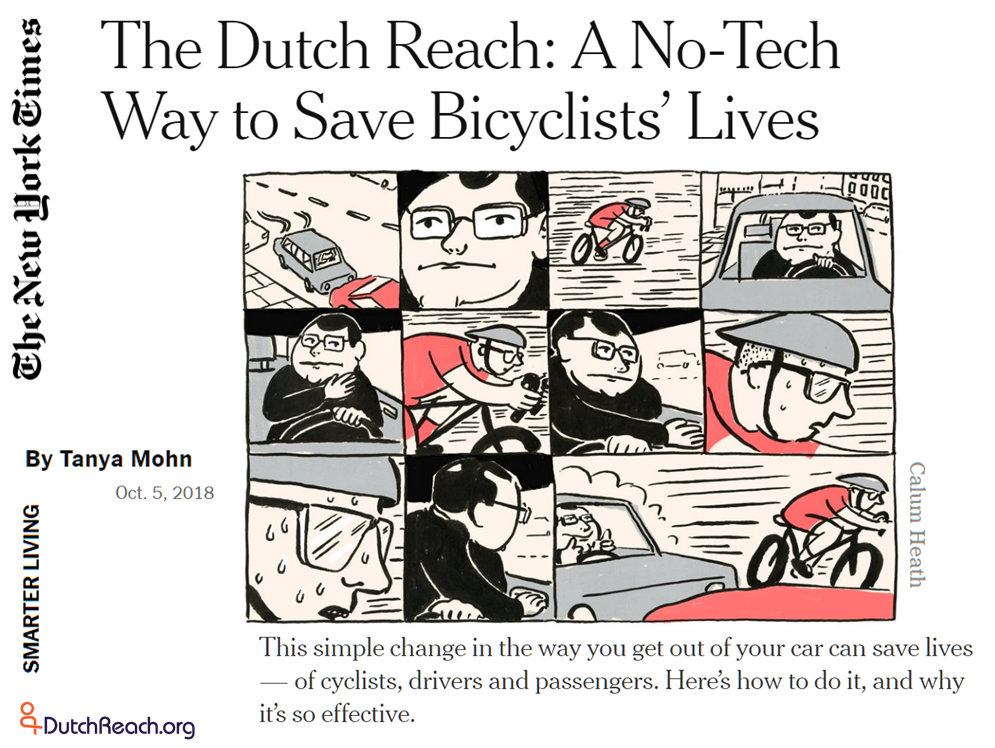
Seven years after The Dutch Way: Bicycles and Fresh Bread by R. Shorto,, the NYT's finds more testimony: The Dutch Reach: A No-Tech Way to Save Bicyclists’ Lives, Smarter Living, by Tanya Mohn, NYT, 6 Oct 2018.
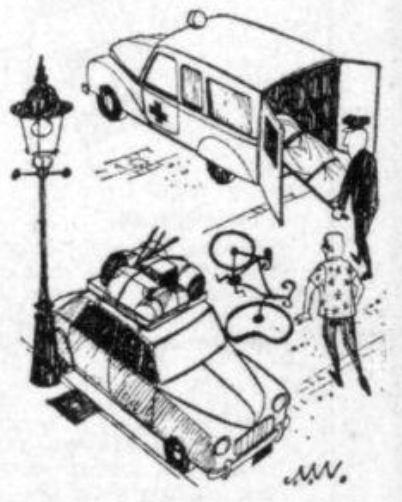
Door collision aftermath: Wegwijzer, De Telegraph, 1961.
Audio: Dutch Ambassador in CA Explains the Dutch Reach

The Dutch Ambassador to Canada in Ottawa explains the Dutch Reach. Audio interview starts at 12m 40s using player here. CBC Radio, 2019.
Emergence of Far Hand Method in the Netherlands - Archival Findings
By 1959, more than a decade before Stop de Kindermoord, Algemene Nederlandse Wielrijdersbond (ANWB) [The Royal Dutch Touring Club] was concerned by the high incidence of car-door collisions amid a rising toll of road injuries and deaths. Preliminary archival research, such as the following newspaper articles from Nieuwsblad van het Noorden (1959) and Leeuwarder courant (1963) advise drivers to use great care before opening. ANWB in 1959 recommends a superior head-check by leaning out through one's slightly opened door [as is most easily accomplished with use of the far hand method, although this is not then specified].
Then in 1961, De Telegraaf, one of The Netherlands' leading daily newspapers, directly asks its readers: "Hoe stapt u uit een auto?" ["How do you get out of a car?"] Then, invoking Queen Juliana's concern about road 'unsafety'- (Her Majesty herself being a bicyclist) - it conclusively prescribes the far hand method. A line drawing illustrates a door crash and the article cites statistics and the harms doorings cause to cyclist and perpetrator each. To date [3 Sept 2019] this 1961 "Signpost" column is the earliest print account of the reach method yet found in Dutch or any other language by this Project.
Five years later - 1966, another road safety columnist for the De Telegraaf [26-02-1966] revisits the topic in Met Het Oog Op De Weg [trans: With A View To The Road] - now based on a reader's tip. The author - a lawyer specializing in traffic crashes - folds the far hand method into detailed sequence of steps which anticipates those now taught by this Project here.
Another five years will pass until an ANWB source recommends the far hand tip in Openen van portieren, Reformatorisch Dagblad, Gepubliceerd op: 24 Juli 1971. Thus far the earliest found inclusion of the far hand method in the ANWB's Theorieboek for learners is in its 2006 2nd edition. It may also have appeared in the the first edition but as yet neither that edition nor any other ANWB publication has surfaced.
Reproductions of these sources are presented on this web page, most being accompanied by transcriptions in Dutch with Google assisted English translations. Click on the archival graphics to enlarge and scroll within or download the text documents. Note as well journalist Vic Langenhoff's impassioned call for citizen advocacy Pressiegroep Stop de Kindermoord which appeared 20 September 1972 in De Tijd in reaction to the death of his daughter Simone, one of 450 Dutch children to be killed by motor vehicles that year alone. [A transcription & English translation of the De Tijd column and more on Stop de Kindermoord are found here.]
HOWEVER...while the Netherlands has this documented history of far hand advice and established practice, the "discovery" or invention of the technique is still uncertain. Indeed, in June 2020 the DRP came across a British road safety poster which suggestively depicts, but does not explicitly instruct, reaching across to the door to twist and achieve a full over-the-shoulder view back. [See poster at right or here.] Curious readers can find a number of such self-reports among the Comments & Replies to Outside's 2016 video How the Dutch Reach Saves Lives (scroll way down for Comments).
Since the this entry was first written (2017) this Project has read comments from people in or from Sweden, Belgium, France, Germany, Italy and Japan who say when learning to drive they too were taught to use the far hand method as the correct way to exit. An Italian wrote he learned it 40 years ago. But to date (Oct. 2021) we have yet to find or receive documentation of the practice prior to the 1961 De Telegraaf [NL] article cited above (or view here).
NOTE: Please contact us should you discover other instances of early use in The Netherlands or elsewhere. Thx! For examples of far hand reach anti-doorings campaigns which pre-date the Dutch Reach coinage & Project, click here.
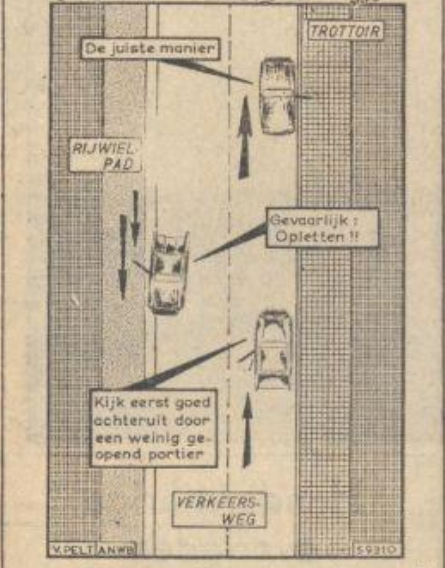
Door collision warning diagram, pre-reach. Nieuwsblad van het Noorden,1959.
RoSPA Shoulder Check Poster 1950
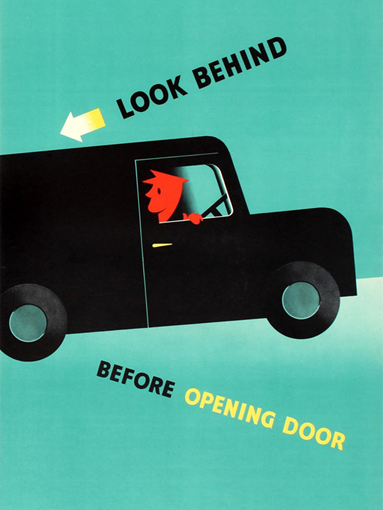
Look Behind Before Opening Door, road safety poster by Leonard Cusden, for the Royal Society for the Prevention of Accidents (UK), 1950, Reused by Safer Essex Roads Partnership here. [Note use of left (far) hand to aid shoulder-check! Was this recommended practice at the time? If so, it would be the first documented teaching of the far hand method.]
1959 ANWB Alarmed by Door Crashes; Advises View Back
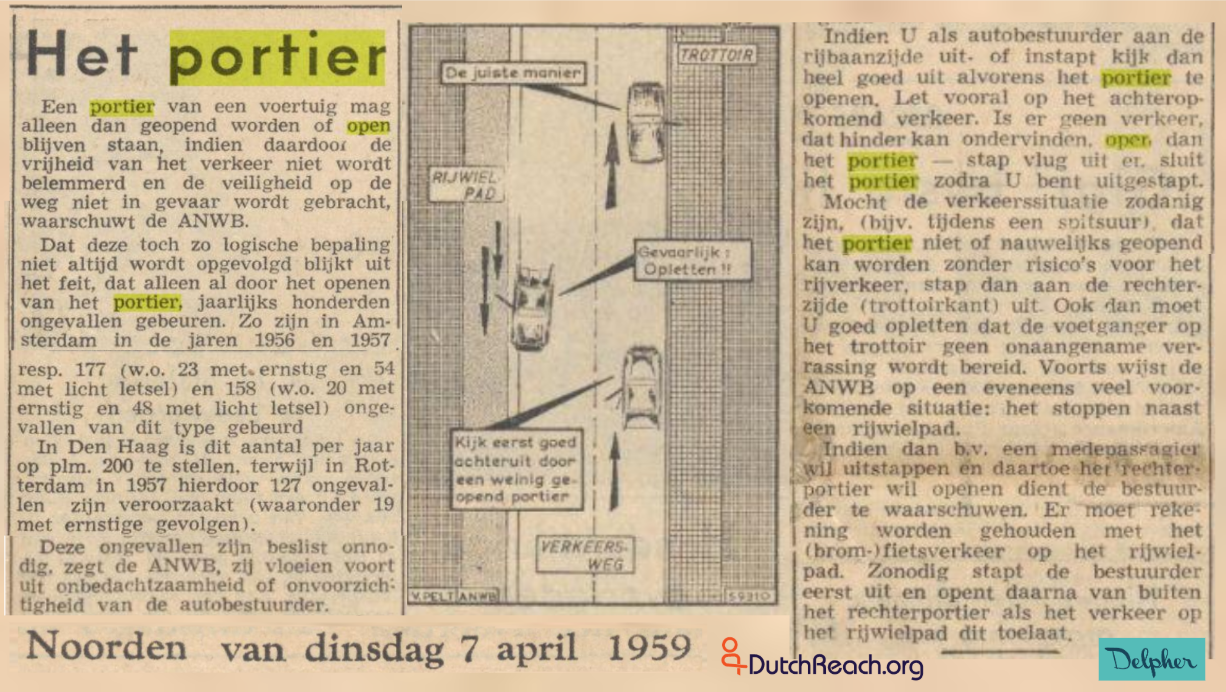
ANWB cites rise of serious car-door collisions and advises great diligence upon exiting, including a 'lean-out' head-or-shoulder check back to scan for oncoming vehiles before opening. Far hand tip not yet cited by ANWB but will be by 1971, Het portier, Nieuwsblad van het Noorden, 7-04-1959, p. 6. Credit: Delpher; Research: Jeroen Bakker. Click to enlarge. See adjacent 'window' for Dutch & English text. Diagram: V. Pelt, ANWB. Caption boxes: De juiste manier; Trottoir;
Kijk eerst goed achteruit door een weinig geopend portier; Verkeers weg; Rijweil pad Gevaarlijk: Opietten!!; V. Pelt ANWB - The right way; Sidewalk; First look carefully through a little opened door; Traffic way; Riding path; Dangerous: Opietten !!; V. Pelt ANWB.
Het Portier, 1959 - Text & Translation
How do you get out of a car? - 1961 Signpost, De Telegraaf
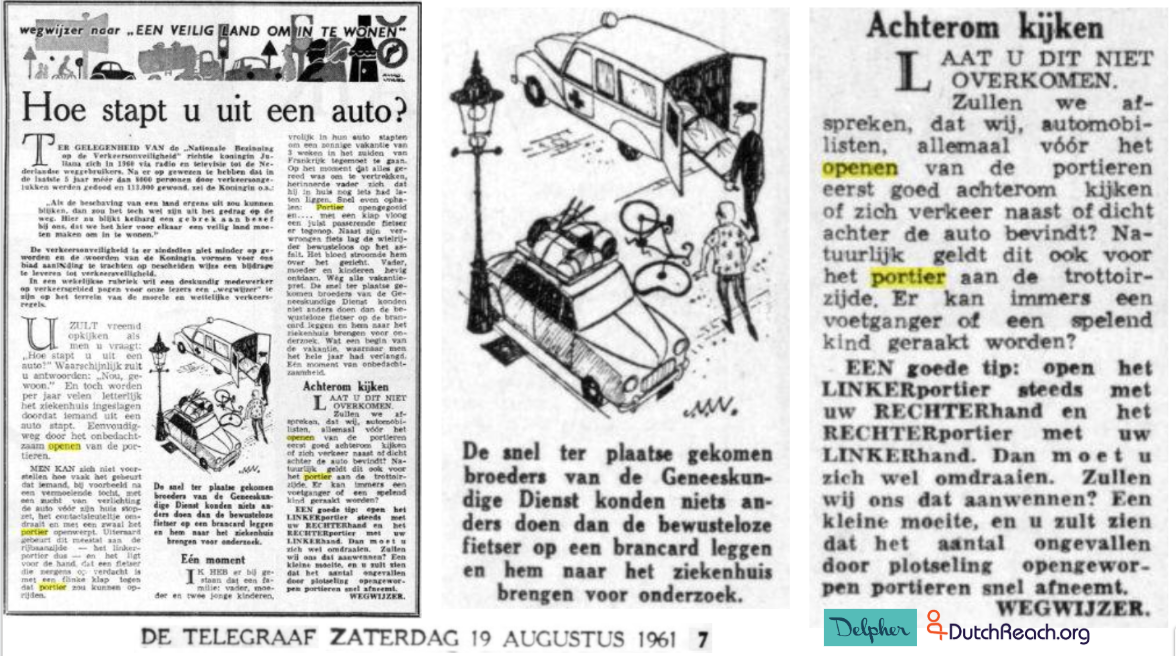
Hoe stapt u uit een auto? (How do you get out of an auto?) Wegwijzer / Signpost, De Telegraph, 19 Aug 1961, p. 7. Possibly the first Dutch account of the far hand aka 'Dutch Reach' method yet found, Click to enlarge; See adjacent text & translation.
1961 De Telegraaf: Earliest 'Dutch' Far Hand Reach Advisory?
A Multi-Step Advisory: Met Het Oog Op De Weg -- De Telegraaf, NL, 1966
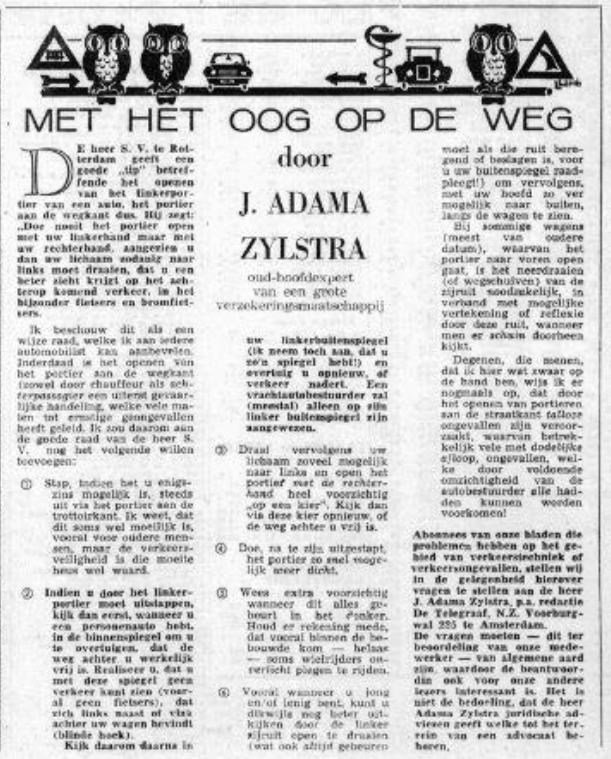
Inspired by a reader's 'far hand' suggestion, the reach method is featured as one part of a safe-egress sequence. MET HET OOG OP DE WEG door J. Adama Zylstra. Telegraaf, 26 Feb 1966, p. 35.
1966 Road Safety Column Advises 'Reach' for Safe Egress
Writing for De Telegraaf (NL) in response to a "tip" by a "Mr. S.V. of Rotterdam," legal columnist J. Adama Zylstra provided this still sound advice to avoid dooring cyclists -- in 1966: Source: Met Het Oog Op De Weg, door J. Adama Zylstra, Telegraaf, 26 February 1966, page 35. This is the earliest print account of the method yet reported to this Project - . Credit: Jeroen Bakker, NL.
Photocopy: Reformatorish Dagblad, 24 July 1971, p.12, top.
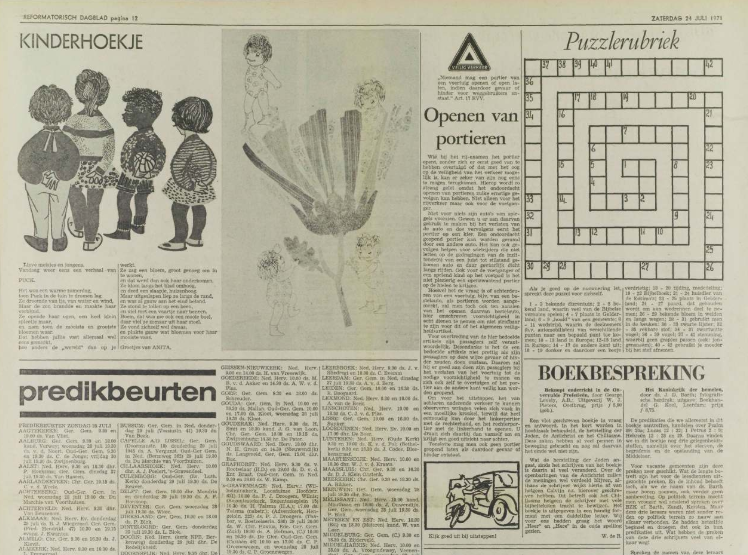
Digitized photo of p. 12 (top), Reformatorisch Dagblad, 24 Juli 1971 with Openen van Portiere. Click image to enlarge.
1971 Dutch Newspaper on Dooring & Far Hand Method
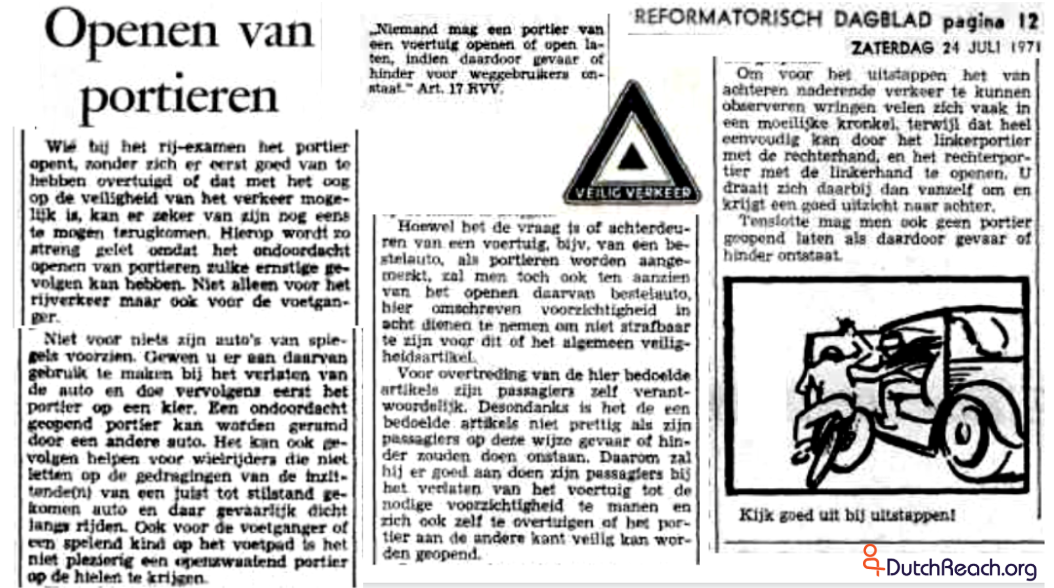
Opening doors - Article describes dooring dangers and recommends the far hand method. Earliest found print documentation to date of the then nameless 'Dutch Reach'. Openen van portieren, Reformatorisch Dagblad, Gepubliceerd op: 24 Juli 1971. Click to enlarge. Full Dutch text & English translation provided below. Credit for archival research: Jeroen Bakker, NL.
Uitstappen Lesson in ANWB's 2006 Dutch Driver Training Theory Book
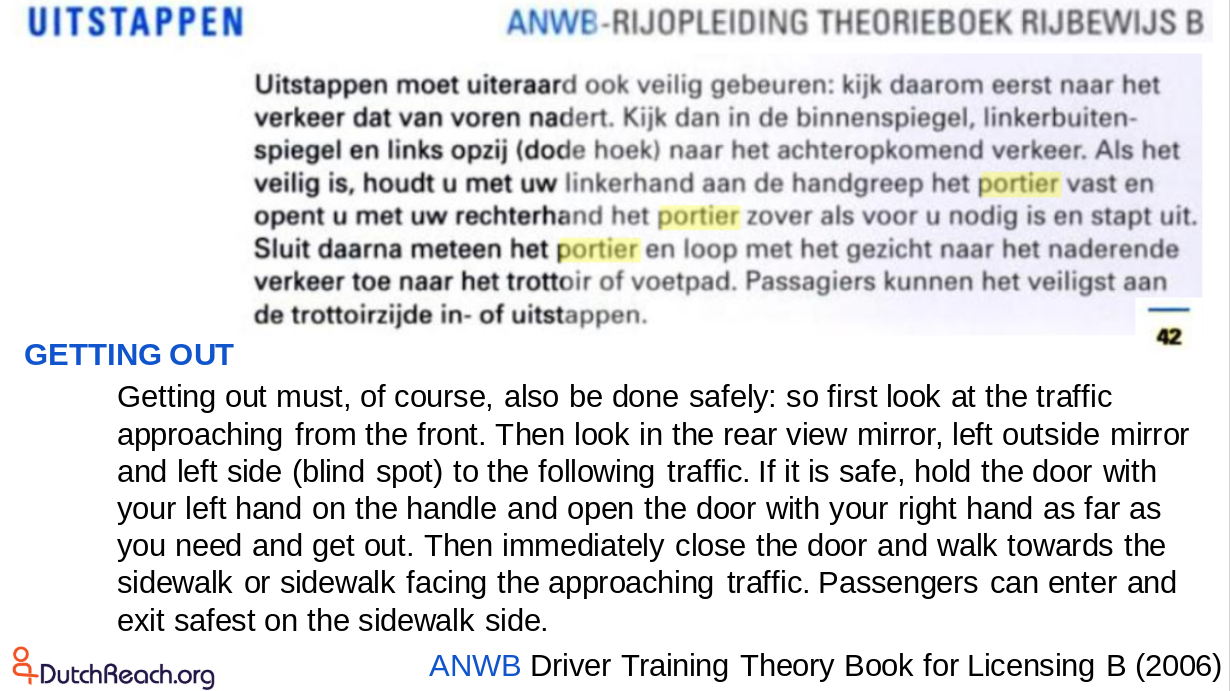
Source: Uitstappen [Getting Out, p.42]: ANWB Rijopleiding Theorieboek Rijsbewijs B, 2nd Ed., 2006. Publisher: Algemene Nederlandse Wielrijdersbond (ANWB) - [Royal Dutch Touring Club's Driver Training Theory Book for Licensing B (2006)]. Click image to enlarge. Note: ANWB is The Netherland's largest traffic & tourism association with currently 4 million members. It is not known to DRP as yet when the far hand reach entered ANWB's Theorieboek.]
Nameless 'Dutch Reach' of 1971
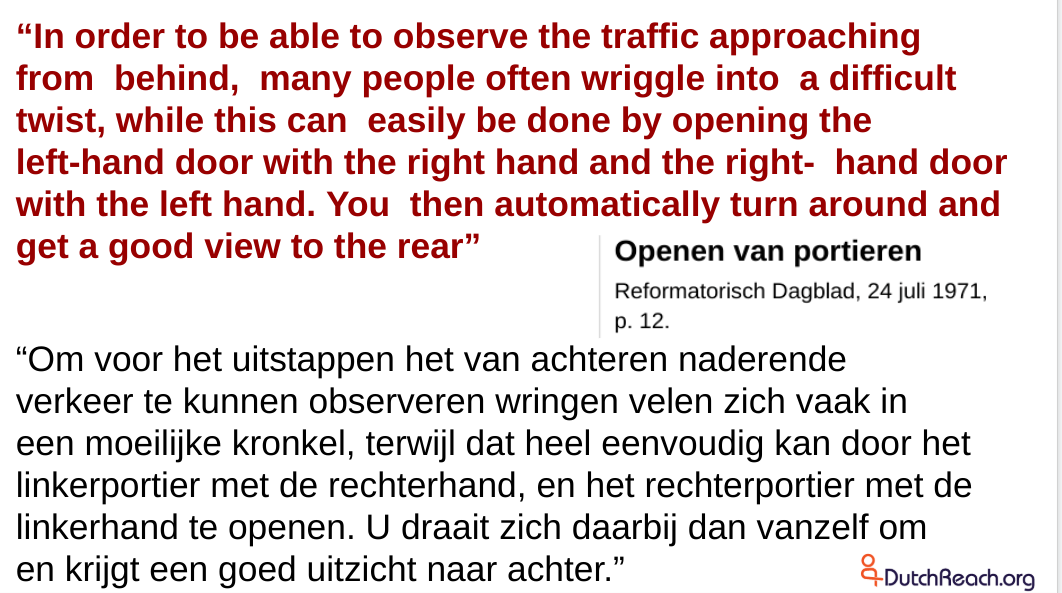
Far hand method as described in Openen van Portieren, 1971. Note: Awareness & use of far hand method in The Netherlands thus pre-dates Stop de Kindermoord onset of March 22, 1973,
Openen van Portieren in English & Dutch
Fietserbond ~c. 1/2 NL Driving Instructors Teach Reach
2006: Dutch road safety authority cites Reach in NL &/or DK
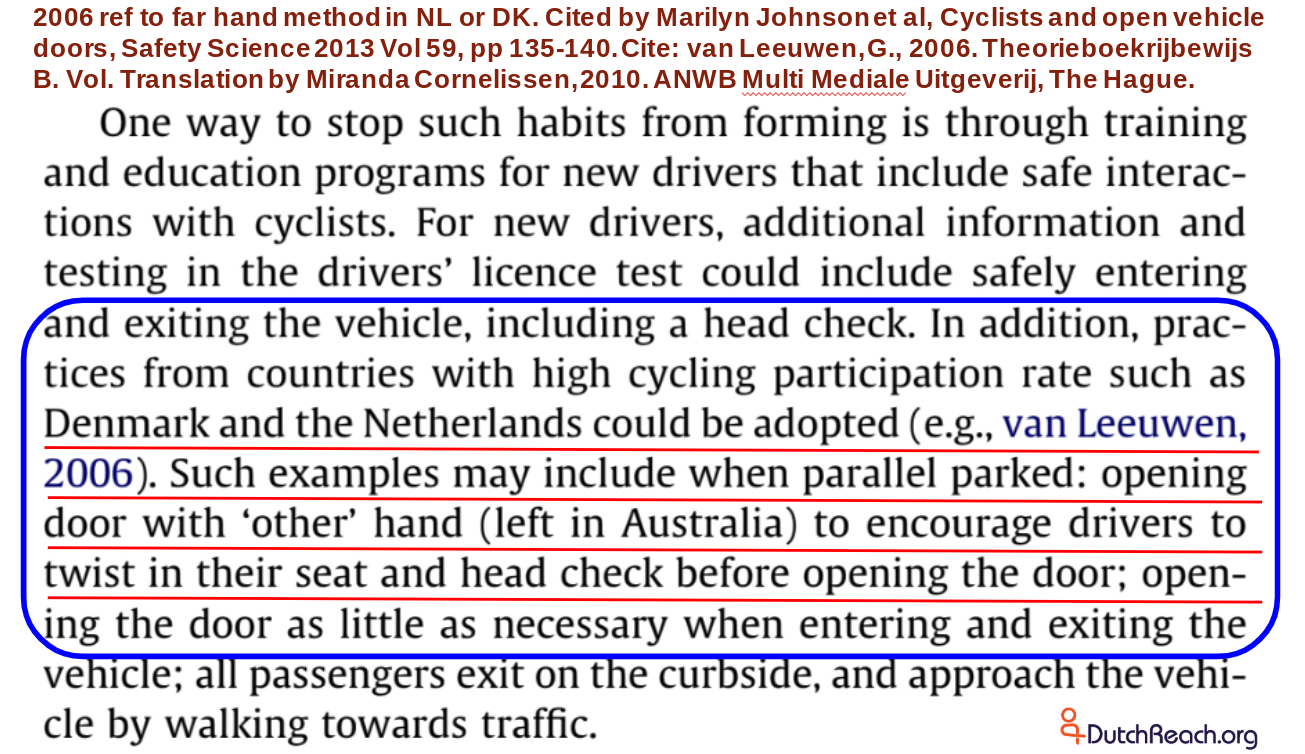
"...practices from countries with high cycling participation rate such as Denmark and the Netherlands could be adopted (e.g., van Leeuwen,2006). Such examples may include when parallel parked: opening door with ‘other’ hand (left in Australia) to encourage drivers to twist in their seat and head check before opening the door;" - This 2006 book by van Leeuwen apparently references the far hand method in NL &/or DK. Cited by Marilyn Johnson et al, Cyclists and open vehicle doors, Safety Science 2013 Vol 59, pp 135-140, p 139. Cite: van Leeuwen, G., 2006. Theorieboek rijbewijs B. Vol. Translation by Miranda Cornelissen, 2010. ANWB Multi Mediale Uitgeverij, The Hague.
Nederlandse Omroep Stichting & Rijles Hulp NL Confirm Dutch Way
![Opmars van de 'Dutch Reach' in Engeland: uitstappen op Nederlandse manier 11-09-2017, AANGEPAST 21-09-2017, 09:37BUITENLAND. Progress of the 'Dutch Reach' in England: getting out [of car] in the Dutch way](https://www.dutchreach.org/wp-content/uploads/2018/06/NOS-Dutch-Broadcast-Fdn-KNOWS-aa.png)
NOS - Nederlandse Omroep Stichting (Dutch Broadcast Foundation ought to know. As reported here by NOS 21 Sept. 2017, Dutch driving instruction companies such as Rijles Hulp NL have taught the far hand method for years. as in their video Lesonderdeel Uitstappen with Step 5 above. Click to enlarge/Klik op de afbeelding om te vergroten. Klik voor NOS artikel / article.
The Dutch Reach by Any Other Name, the Same
![Use the Dutch Reach, that is, hold the door with your nearest hand and open it with the farthest hand, advises the cyclists' association. “Look in your mirrors and then through the slightly opened door to the rear, so that you are sure that no cyclist arrives and you can safely get out. By holding the door, you do not open it too far and you prevent it blowing [open] through the wind. That also applies to the passenger side.](https://www.dutchreach.org/wp-content/uploads/2018/06/NOS-Opmars-Dutch-Reach-Engeland-transNL-Ea.png)
NOS author notes that the far hand method is commonly taught by driving instructors in The Netherlands. From Opmars van de 'Dutch Reach' in Engeland: uitstappen op Nederlandse manier, about "Dutch Reach" progress in England, 21 Sept 2017. Klik op de afbeelding om te vergroten. Click image to enlarge. Klik voor artikel/article.
NOS neemt nota van voorafgaand gebruik of 'Reach' in NL
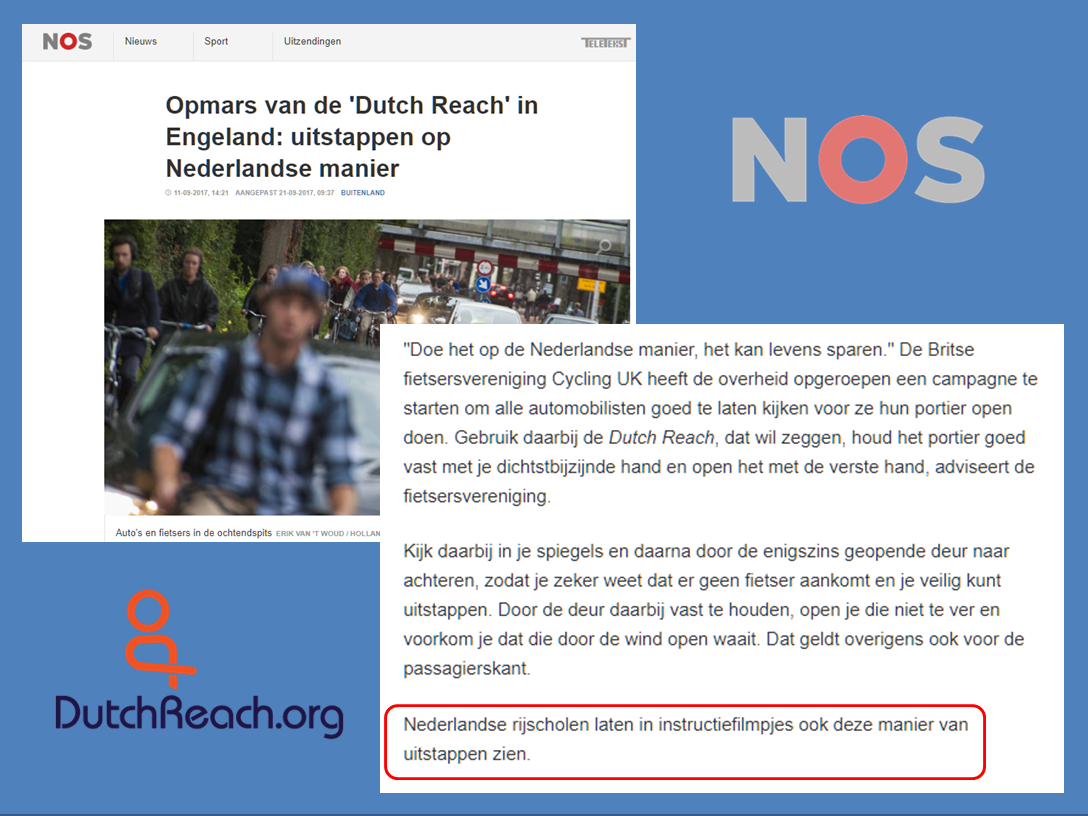
Met betrekking tot de aanwezigheid en praktijk van de 'bereik'-methode in Nederland, let op: "Nederlandse rijscholen laten in instructiefilmpjes ook deze manier van uitstappen zien." Opmars van de 'Dutch Reach' in Engeland: uitstappen op Nederlandse manier, NOS,11-09-2017. Klik op de afbeelding om te vergroten; click to enlarge.
"REACH" A CULTURAL NORM
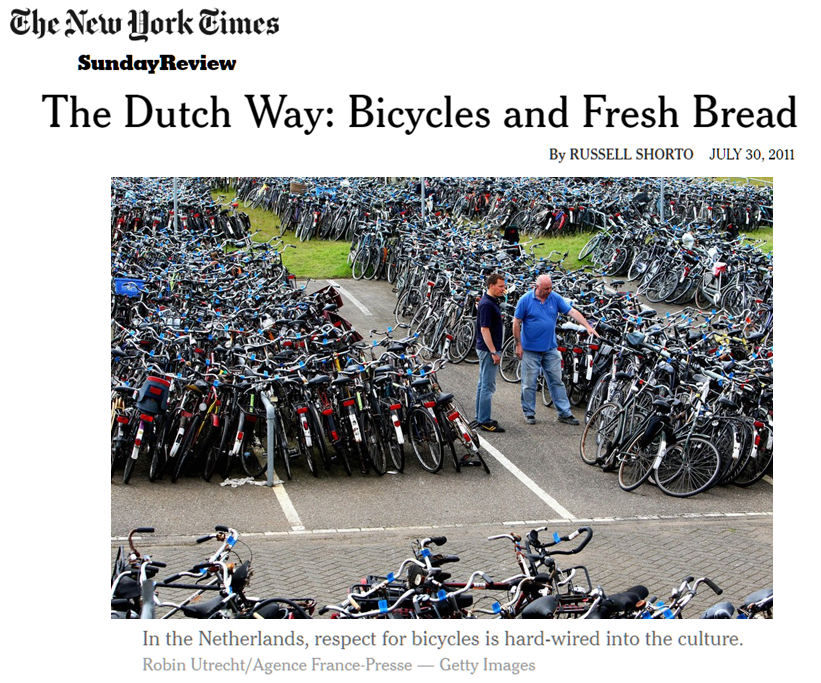
First known USA news report of Dutch far hand dooring countermeasure. New York Times: The Dutch Way: Bicycles & Fresh Bread, by Russell Shorto, July 30, 2011.
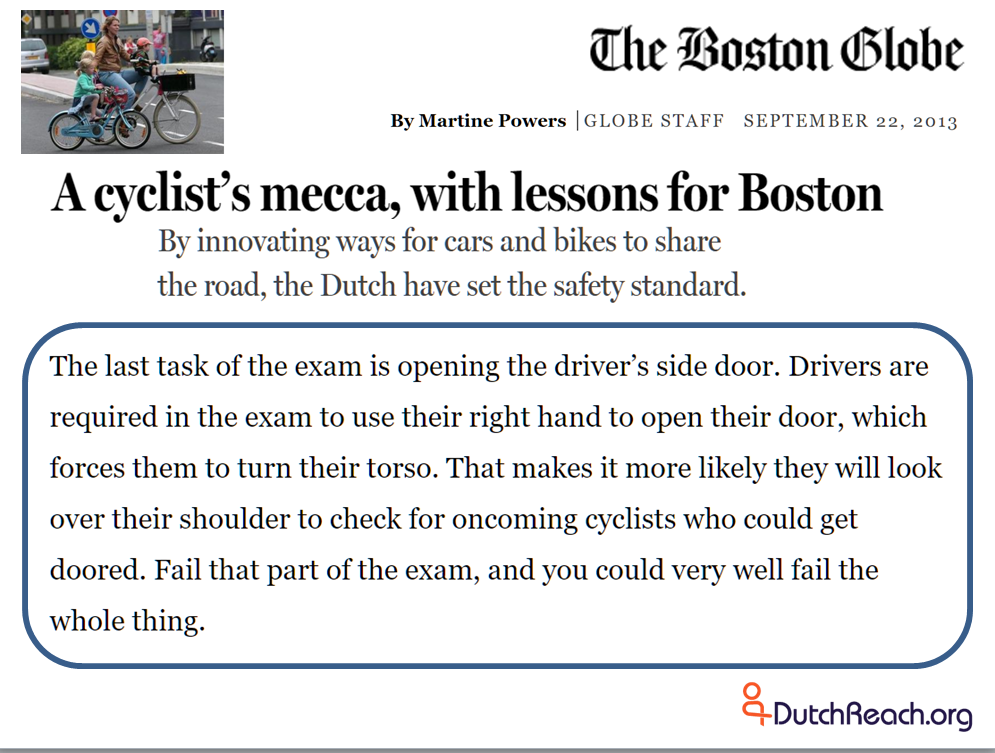
On assignment to study NL cycling culture, the reporter found the 'reach' in use. Martine Powers, Boston Globe, 22 Sept. 2013. See 5th section on driving exam.
Stop de Kindermoord
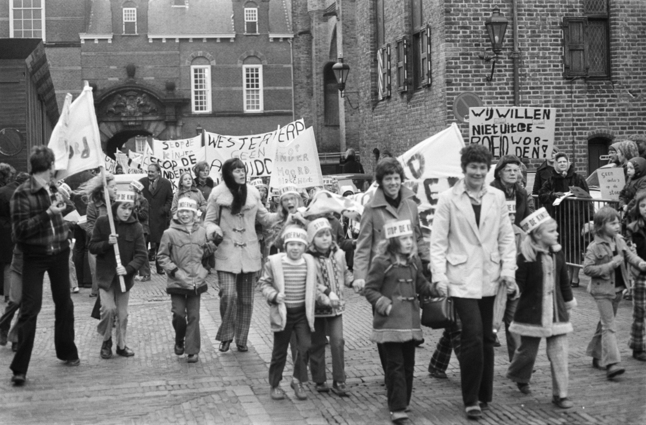
Stop de Kindermoord protest movement of the early 1970s in NL which led to major road safety reforms we see today.
2015 'SAFE VEHICLE EXIT' VIDEO TEACHES THE REACH (in Dutch!*)
Below is the translated text.
Exiting a car
When exiting a car it’s important to prevent dangerous and hindering situations for yourself and other road users. In this tutorial, you will learn how to exit your car safely. At the end of your driver’s exam you might be asked to exit the car and wait inside the driver’s center to find out whether you passed. This is done to observe how you exit the car and whether you’ll adhere to safety guidelines.
Pay attention, because you could fail your driver’s exam if you don’t!
We will now show you step-by-step how to exit a car safely.
Exiting the car
Step 1
Remove the key from ignition and fold it up, if possible.Step 2
Look in front of the car, in the inside mirror, the left outside mirror and over your left shoulder!Step 3
If there’s no oncoming traffic, firmly grab the door handle with your left hand to prevent losing your grip on the door by the wind when opening it. [See 'Vehicle Wind Damage' below].Step 4
Wait until there is no traffic before you press the button to fold in the outside mirrors.Step 5
Unlock the door with your right hand!Step 6
After closing the door, you head into the direction of oncoming traffic to walk to the sidewalk.Step 7
Once you’ve safely reached the sidewalk, you can lock the car doors with one press on the key(fob).
_______________
Translation most kindly volunteered & provided by Femke Zeilstra (11 February, 2017).
Wind, Windmills & Car Doors?
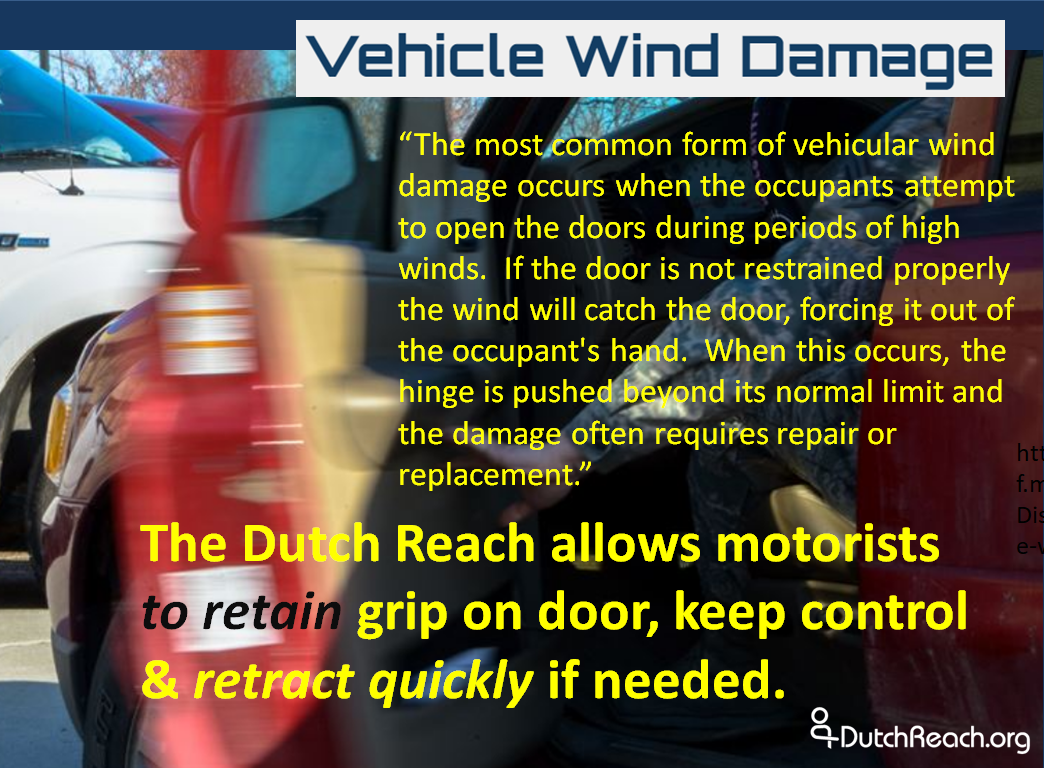
Vehicle Wind Damage to Vehicle Doors, Mountain Home Air Force Base Staff Report, Idaho. [NOTE: Step 3 of the 2015 Dutch driver instruction video above: Uitstappen uit de auto [Safe Exit of Vehicle], explains that the 'Reach' method keeps control of door in high wind. That early era auto doors were light-weight and that the winds of the Low Lands often mistook them for windmills, may also help explain the far-hand's popularity among Dutch drivers. ed.]
2 Hands Control Door
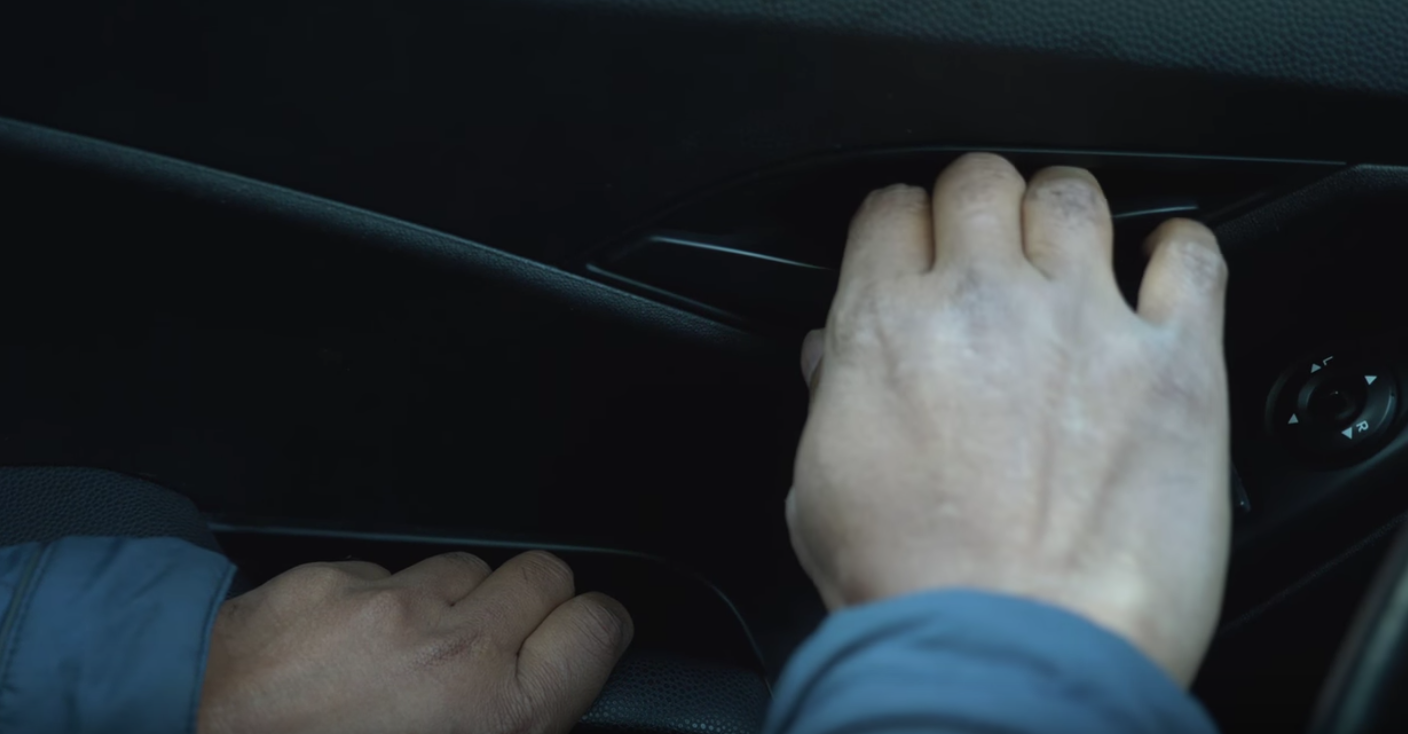
Near hand prevents wind-blown opening & allows quick retraction while far hand operates latch as reaching across t.urns driver outward. Photo: Rijleshulp.NL video.
SundayReview | OPINION
The Dutch Way: Bicycles and Fresh Bread
By RUSSELL SHORTO
RISE OF THE DUTCH REACH METHOD: NETHERLANDS' 1970s ROAD CARNAGE
AN INFORMAL HISTORY OF THE REACH METHOD
The Reach, opposite or far-hand dooring countermeasure arose to common practice in the Netherlands in the 1970s. It was a result of a then national road safety movement mobilized by parents of the Stop de Kindermoord protest movement, parents who had lost or feared losing their children to rampant road carnage.
Their protests led the country to adopt major reforms, practices and infrastructure designs to assure that such tragedies would end. Five decades on a majority of the Dutch have little or no memory of those terrible years, nor of Stop de Kindermoord and the efforts made by activists and officials which, over time has made NL the road sharing mecca it is today.
Background to the 'reach across' method
1) Fifty years ago The Netherlands (population 13 million) was NOT a model for road sharing safety.
2) NL citizens were suffering terrible road carnage. Over 3300 people, including 450-500 children - and several hundred more teenagers, were killed in traffic crashes in NL in 1972. (See traffic fatality chart by age at right)
3) NL was finally recovering economically from WWII. More and more motor vehicles and mopeds were now contesting the streets filled with pedestrians and bicycles.
4) Grieving and aggrieved parents took to reclaim the streets from motor vehicle mayhem: Their 'Stop de Kindermoord (Stop Child Murder) protest campaign led to the Dutch revolution in road safety which we envy today. [In Amsterdam the Provo's also fought against the 'modernizing' city government whose urban plan would destroy the Jewish ghetto where the radical squatters movement was based, by running a motor way through it. And the Fietsband as well strongly opposed the tearing out of bike tracks to make room for car 'culture'.]
5) As of 2016, with its population now at 17 million, 625 road fatalities occurred in NL. Dooring fatalities, while they still do occur, are now rare. In the early years behavior change practices - traffic code reform led to better driver education and conduct. Infrastructure innovations followed and innovative new road design, signage were implemented. Procedures to investigate each road incident and correct road conditions has become standard.
6) Those bad times though are now forgotten in NL and virtually unknown to foreign admirers of NL road safety culture. Most Dutch citizens now were not aware adults nor even alive at the time. Many of that reformist age are no longer living.
7) That the 'reach' method never had a given Dutch name also contributes to its modern obscurity. It may have arisen independently, spread or was shared across neighboring boarders. This Project has received reports of the method also being taught and/or practiced in Sweden, Germany, France and Belgium, and in Denmark by the early 70's.
6) But senior citizens and older road safety experts in NL are aware of this history. The Dutch traffic code reflects those reforms with stringent standards for driver licensing, including the avoidance of dooring. And recent archival research by a Dutch citizen volunteer for this Project has, three years after this effort to document the 'reach' method as having Dutch roots, now uncovered multiple print sources documenting awareness of the far hand method as early as 1961 as it began to spread into Dutch awareness and road safety teaching.
7) According to older experts and a foremost Dutch cycling historian, the far hand method was once widely considered the way one opens a car door - its hayday likely being the 1970's & 80's.
8) Dutch driving schools and instructors still teach the method as the best way to pass the vehicle parking and exiting section of the licensing road test. Witness Rijleshulp's vehicle egress instructional video (in Dutch, but an English transcript is found by scrolling far down here).
7) In September 2017, The Royal Society for the Prevention of Accidents (UK) publicized the Dutch Reach in a video - How to do the Dutch Reach (filmed in NL) which climaxes with a Dutch driving instructor who demonstrates how he teaches student drivers to exit. He never heard of the term 'Dutch Reach' but that is exactly what he demonstrates.
8) Some time early this century, perhaps as more and more cyclists and road safety expert traveled to the Netherlands to learn about their road sharing revolution, news of the method began percolating out. That the method was still anonymous - unnamed - did not help. Also, the method was also quite invisible - hard to notice. The innovative infrastructure and massive presence of cyclists and pedestrians was what caught visitors' attention.
9) Several names did emerge for the reach measure and were found in print in the 2010s: In New Haven, CT, USA it was referred to as The Amsterdam or Northern European Cities' method. In Fort Collins, CO, USA it was dubbed 'the Opposite Hand Trick'. In San Francisco CA, Montreal Canada, and Victoria AUS, it was just described, no name given or invented.
10) The tag "Dutch Reach" was coined by a retired Cambridge, MA, USA physician - as he founded this Project - in order to promote the practice with a meaningful and catchy term. Fortunately it also had - unbeknownst to its chrisen'er- several risque connotations. This made it extremely interesting, puzzling and attractive to the wired generation - which inspired and powered Outside Online's rapidly viral and internationally popular video posted within two weeks of the Project's first public notice: The Dutch Reach - Safe For Work (9/19/2016).
11) So indeed, the term "Dutch Reach" was not coined in The Netherlands by a Dutch citizen. But this simple, ingenious safety measure can justifiably claim to have very strong Dutch heritage if not original provenance. A better history is yet to be written, if one knew where to look, whom to speak to, if they are still alive....
12) The point is, that the Dutch Reach method by whatever name and whichever provenance, works! It is far far safer than the near hand alternative. (For comparison see here & here.)
13) Wikipedia (English edition) now includes a well-referenced Dutch Reach entry under Dooring. The early version incorrectly asserted that the 'Dutch Reach' was named so because the Dutch are known for bicycle and road safety culture is not sufficiently true. To set the record straight - I being he who coined the term in 2016 - referenced the Dutch because based on my understanding at that time, which has since seemed confirmed by archival print evidence and personal communications with Dutch cycling experts. The currently available evidence is consistent and reputable: the method was in very common use in Holland in the decades following Stop de Kindermoord. And it apparently continues to be taught and practiced to some unknown but demonstrable extent. Thus far I have yet to find or receive documentation that the method was common or as common in any other nearby country at that time.
14) See: Historically Speaking: 'Dutch Reach' for a semi-independent pedigree assessment for the meme.
15) APPEAL! Do you have knowledge, oral history, print or documents regarding the origin, implementation and spread of the 'reach' countermeasure in NL or elsewhere?
If so, please do share this information with me by email at Contact!
-- Michael Charney, Dutch Reach Project
1963 ANWB Door Opening Advisory Pre-'Reach'
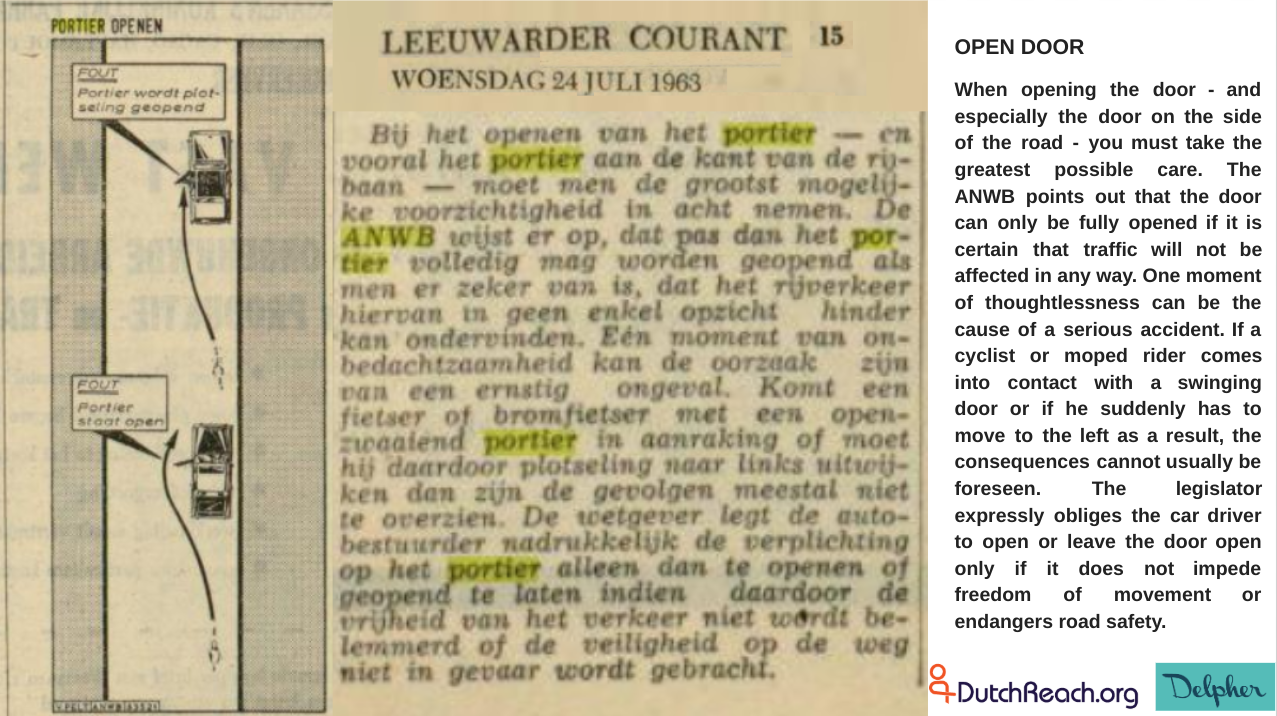
Brief road safety advisory inserted into financial page of Leeuwarder Courant of Friesland, NL, p.15, July 24, 1963, calls for vigilance on egress but makes no mention of far hand method. Click to enlarge.
NL not always a safety mecca
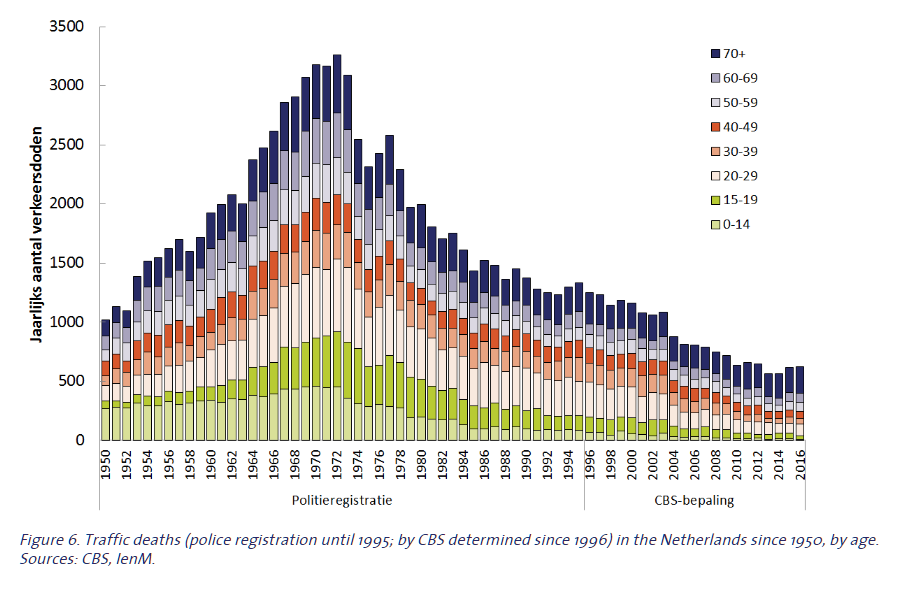
NL road fatalities by age of victim, 1950-2016. Peak coincided with Stop de Kindermoord protests.
Sachverständigengutachten zum Einsatz der Reach-Methode in den Niederlanden
The New York Times Sonntagsrückblick | MEINUNG
Der niederländische Weg: Fahrräder und frisches Brot
von RUSSELL SHORTO 30. Juli 2011
Um ein kleines, aber aussagekräftiges Beispiel zu geben, das von meiner Freundin Ruth Oldenziel, Professorin für Technologiegeschichte an der Universität Eindhoven, gezeigt wurde, sollen holländische Fahrer aussteigen, indem sie mit der rechten Hand zum Türschloss greifen. Dies zwingt einen Fahrer, Schultern und Kopf zu schwenken, so dass man vor dem Öffnen der Tür sehen kann, ob ein Fahrrad von hinten kommt. Ebenso muss jedes niederländische Kind eine Fahrradsicherheitsprüfung in der Schule bestehen. Die Koexistenz verschiedener Reisemöglichkeiten ist fest mit der Kultur verbunden.
--- Vierter Absatz [Amateur-Übersetzung von Google unterstützt! - Editor]
Might DR be Danish or ...?
The origin of the far hand method is not and may never be settled.
I have heard, seen anecdotal reports, comments, suggestions that it has to some degree been practice in several northern european cities and countries as well as NL as far back as the very early 70s or late 60s. These include NL, Denmark, Sweden, Germany, Belgium and France.
But thus far it seems NL has been the epicenter of use, and was considered the common sense way to open on exiting possibly now for 5 decades.
A radio program in Denmark which reported on the Dutch Reach campaign in 2016 got a comment from one listener who said he/she was taught it in Denmark in 1973. Another listener, an expatriate from NL living in Denmark said she was taught and tested for it in NL in 1972.
There's no reason to believe that this method couldn't have originated independently in many places with the introduction of the automobile, even before or after the introduction of side/wing mirrors - whose quality even if present could have been far poorer than the ones we have today.
If you or anyone has information on the early history of the reach method please share it with us using Contact!
Wind-blown Necessity?

Holland is known for its windmills for a reason. Were Holland's winds a factor for adopting the Reach? This 2015 Dutch Safe Vehicle Egress Lesson at Step 3 cites door control vs wind.
DutchNewsNL Slights the Dutch!
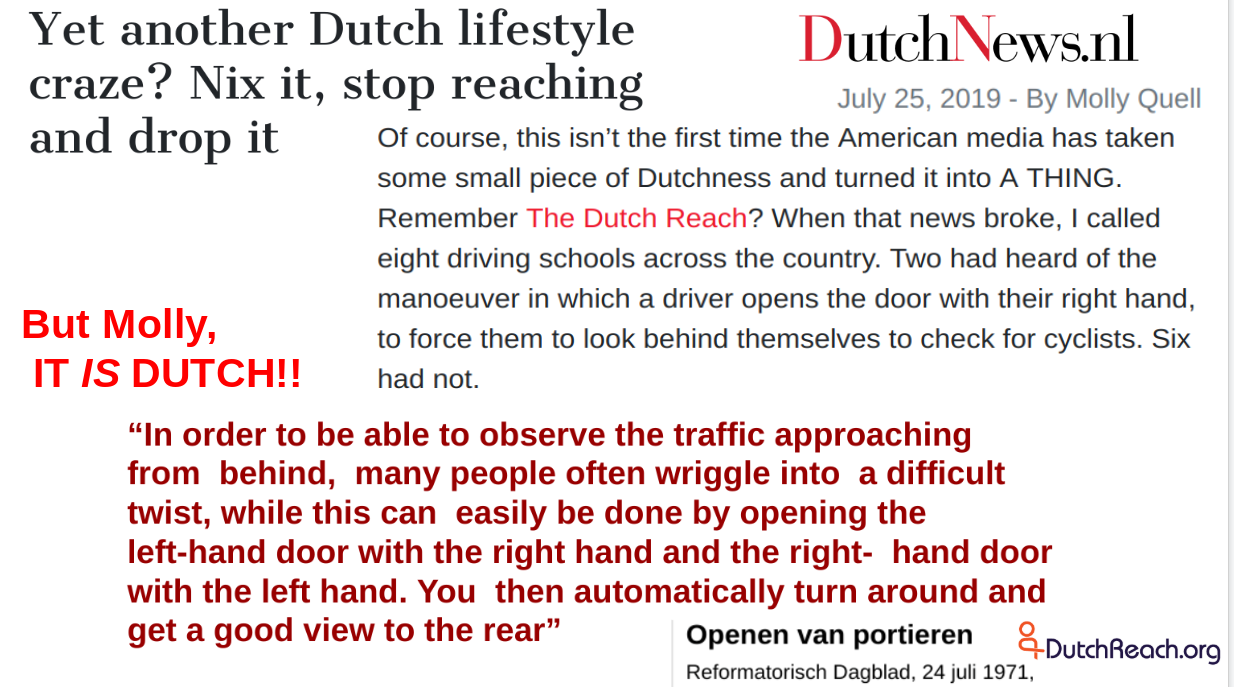
Yet another Dutch lifestyle craze? Nix it, stop reaching and drop it, by Molly Quell, DutchNews.NL, July 25, 2019. Columnist Quell confirmed Reach method is [still] taught in NL but failed to dig deeper as the Dutch were first adopters 5 decades ago. See: Openen van portieren & more here. As noted in the discussion of Dutch Reach history on this web page, Quell and DutchNewsNL are not alone in sporting ignorance of their own nation's road 'unsafety' history and NL's early and likely unique common adopti0n of the far hand countermeasure.
But while now rare, drivers still door cyclists in NL
Fietsster (55) overlijdt na botsing met autodeur in Almelo
Cyclist (55) dies after colliding with car door in Almelo
ALMELO - A 55-year-old woman from Almelo died last Sunday from her injuries she sustained earlier last week in an accident at her place of residence. - 1/24/2018.
The cyclist collided on Wednesday, January 24, around 6:10 pm on the Brugstraat in Almelo with an open door of a stationary car. The woman was transferred to the hospital with injury and died of her injuries a few days later.
The police are investigating the case and are asking witnesses to report.
[Note: Staff at the Dutch Cycling Embassy, ['a public private network for sustainable bicycle inclusive mobility. We represent the best of Dutch Cycling: knowledge, experience and experts..."] when queried by this Project on the history of the reach method in the Netherland, have replied anecdotally that the far hand method was not known to them and not know to be taught in The Netherlands, and that government strategy is to focus on engineered solutions, ie. infrastructure, signage etc. to reduce transport dangers, rather than education or enforcement.
However in 2016 the Dutch Reach Project received comment from the road expert at SWOV [Institute for Road Safety Research (NL)], who had originally confirmed to this Project the decades old Dutch common practice of the reach method, that doorings had increased in incidence in recent years and professional colleagues were considering the need for resumed prevention education and behavior change campaigns. -( ed., DR Project)]
Dooring Death in Almelo, NL - 1/24/2018
"#DutchReach" forgotten in #NL?https://t.co/jXM1JEz39B@Cycling_Embassy @BicycleDutch @fietsprofessor @velotropolis @BicycleMayor020 @fietsersbond #Delft #Groningen #Amsterdam @SWOV @DutchNewsNL #bestuurder #passagier #veiligheid #autodeur #Utrecht #dooring
See DutchReach[.]org— Michael Charney (@DutchReach) July 1, 2019
For Skeptical Dutch Citizens....
Het was gebruikelijk in NL in de jaren 70 en 80 toen NL een massale bloedbad op de weg onderging. Het wordt nog steeds aangeleerd. Zienhttps://t.co/EuSwreA4oZ
Nederlandse rij-instructeurhttps://t.co/SMF7gY0yYl
Uitstappen uit de auto: https://t.co/tx3z5XYHPF #dooring #dutchreach pic.twitter.com/AgbJ5OZYES— Michael Charney (@DutchReach) August 27, 2022
